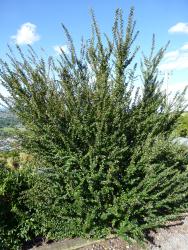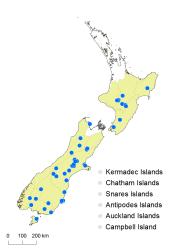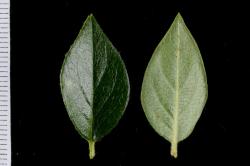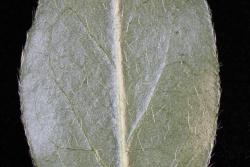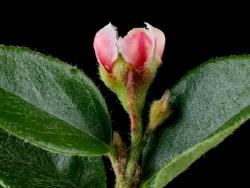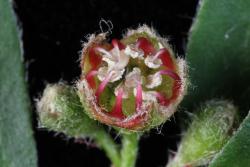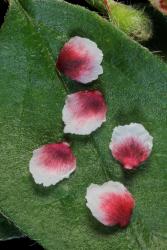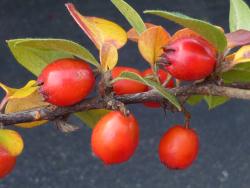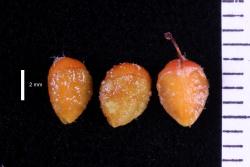- Taxon
- Weed
Erect shrub, 1.5–3.5 m tall, semi-deciduous to deciduous in New Zealand. Branches stiffly erect; branchlets glossy red-brown, lenticels and papillae from broken hairs present, branchlet hairs dense, white or yellow; stipule persistent, 4.5–6.5 mm long, red, green, or red-brown. Leaves crowded on branches, 24–35 mm long, lamina 12–31 mm long, 14.5–19 mm wide, ovate to elliptic, plane to distinctly V-shaped, 250–400 µm thick, petiole 3–5 mm long, hairs moderately dense, yellow; leaf base cuneate to rounded; leaf apex acute, apiculus straight; lateral veins in 3–4 pairs, midvein and base of lateral veins impressed above and projecting below; upper surface smooth to slightly rugose, mid green to dark green, dull to glossy, upper-surface hairs sparse to moderately dense and yellow; margins plane with hairs sparse to moderately dense and yellow; lower surface not glaucous, hairs sparse to moderately dense, straight, yellow.
Flowers solitary or in a simple corymb of 2–3 flowers, 14 mm long, rachis hairs dense, yellow; pedicel 2.0–5.0 mm long, hairs moderately dense, yellow. Flowers 4.5 mm diameter. Hypanthium green, usually glabrous except for fringe of hairs, sepals 1.8–2.1 mm long, 2.3–3.2 mm wide. Petals pink in bud, when open erect, pink centrally with white margins, 3.4–3.6 mm long, 3.3–3.4 mm wide, base clawed, tuft of hairs present or absent, margins appear torn. Stamens 18–20; filaments 2.3–2.5 mm long, white in bud, turning pink; anthers white, 1.1–1.2 mm long; styles 3–4, 2.0–2.2 mm long. Fruit vivid red (RHS 45A), ellipsoidal to obovoid, 6.5–11 mm long, 5.4–8.4 mm diameter, calyx closed or open, hairs sparse or none. Pyrenes 3–4, 4.8–6.0 mm long, 2.5–3.8 mm wide, hairs sparse at apex, slightly umbonate, style attached 1.4–2.5 mm below pyrene apex.
Kumar & Panigrahi (1992) pointed out that Cotoneaster symondsii T.Moore is an older name for what might be this species. Moore’s name was effectively published but no type matching the details in the protologue can be found. Published work has been divided over the use of the name C. symondsii vs. C. simonsii. Fryer & Zika (2014) resolved this problem by neotypifying the name C. symondsii in such a way that C. symondsii is a synonym of C. marginatus and the established use of the name C. simonsii is undisturbed.
An erect shrub, with branches that are stiffly erect, not arching. Stipules are persistent and obvious. Leaves are elliptic or ovate with an acute apex, the leaf underside glossy, not glaucous, and moderately densely hairy with white or yellow straight hairs that persist. Flowers with petals pink, dark centrally, erect, filaments white turning pink, anthers white, styles/pyrenes 3(4), fruit orange-red to red, ellipsoidal, longer than wide, the navel slightly open due to projecting calyx lobes.
Most similar to Cotoneaster divaricatus. Cotoneaster simonsii belongs to the group of species that are not glaucous on the lower leaf surface but have sparse, straight (strigose) leaf hairs. The group includes C. simonsii, C. divaricatus, C. horizontalis, C. marquandii, and C. perpusillus. Of these, C. simonsii attains the greatest height: up to c. 3 m, with erect branches. Smaller plants of c. 1 m height are difficult to distinguish from C. divaricatus as the leaves have a similar hair distribution and shape, particularly the acute to cuspidate leaf apex. Pyrene number overlaps in the two species, but C. simonsii has 3(4) pyrenes, while C. divaricatus has 2(3) per fruit.
Cotoneaster marquandii is similar to C. simonsii in having orange obovoid fruit with an open navel when ripe, and having obvious persistent stipules. It differs from C. simonsii in having horizontal branches with a herringbone pattern, rather than erect branches. It also has smaller leaves, 8.5–11.0 mm wide, not 14–19 mm wide as in C. simonsii.
Cotoneaster horizontalis and C. perpusillus are prostrate or semi-prostrate rather than erect shrubs and have smaller, round leaves.
Gisborne (Eastwoodhill, 1989), Volcanic Plateau (Taihape, 1991, 2001; Raetihi, 2006; Ōhakune, 1964; Whakapapanui R, 1971; Mangaweka, 1994), Southern North Island (Akatārawa, 1953; Wallaceville, 1952), Sounds–Nelson (Torrent Bay, 1996), Westland (Maruia Falls, 2015; Springs Junction, 1991; Taipo Valley, 1979), Canterbury (Hanmer, 1988; Kōwai River, 1962, 2000; Rākaia Gorge, 1994; Alford Forest, 1972; Banks Peninsula, 2014; Castle Hill, 1993; Methven, 1970; Ashburton, 1956; Peel Forest, 2015; Hunters Hills, 2015; Fairlie, 1957; Mt Cook, 1969; Lake Ōhau, 2015), Otago (Dunedin City, 1994, 2004; Otago Peninsula, 1984; Clyde, 1989; Queenstown Hill, 1989), Southland (Tahakopa Bay, 1994; Wyndham, Mossburn, 2001), Fiordland (Lake Manapōuri, 1973; Lake Monowai, 1997), Stewart Island (Half Moon Bay, 1962). The most common naturalised species in New Zealand and one that invades native forest as an understorey species. Common in cultivation throughout New Zealand.
CHR 70941, A.J. Healy 50/415, 29 Nov. 1950, Hutt Valley, near Upper Hutt, in Healy (1958, p. 536).
Flowering: late October to December; Fruiting: January to March, persisting over winter
Tetraploid (Fryer & Hylmö 2009), confirmed by flow cytometry of four specimens: CHR 637417, CHR 635258, CHR 637361, CHR 635270; but CHR 635040 was pentaploid.



